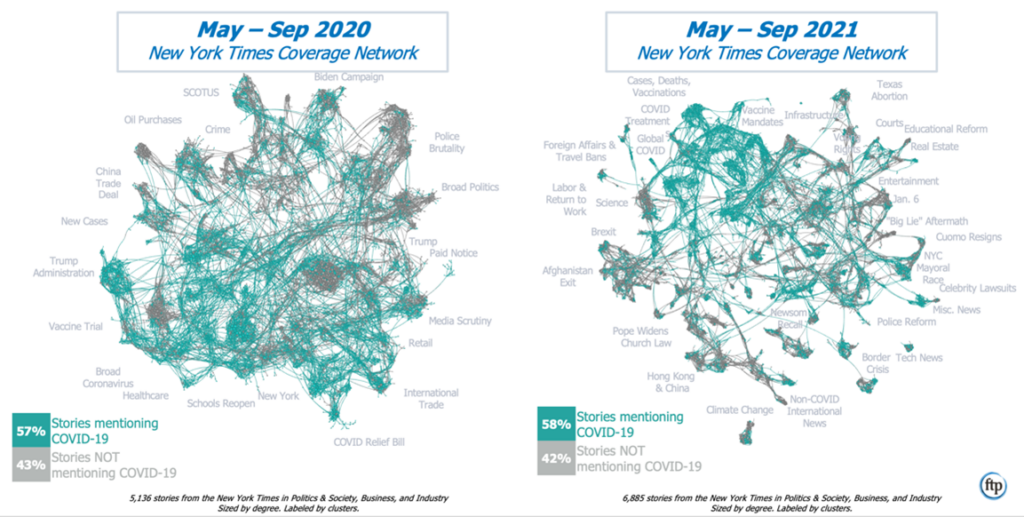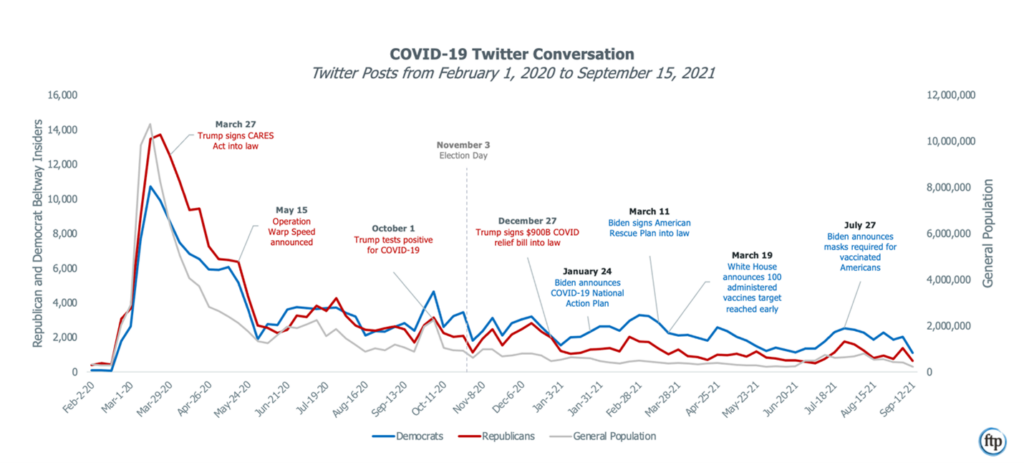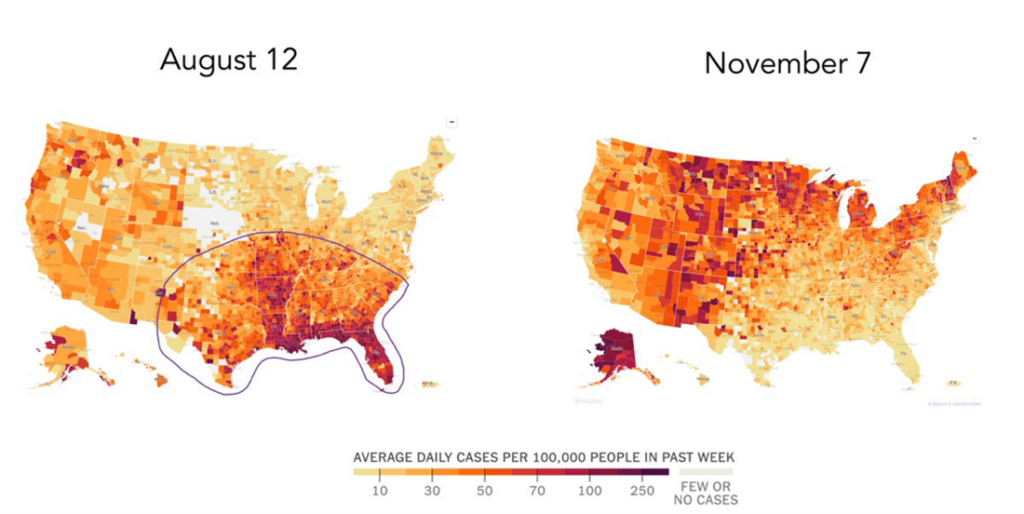Forbes Tate Partners (FTP) recently hosted a virtual conversation featuring policy and insights experts and the Bipartisan Policy Center’s Chief Medical Advisor, Anand Parekh. The discussion focused on the COVID-19 conversation on social media, policy trends in the states, and the federal response to the current pandemic and how policymakers are preparing the nation for future challenges. The panelists included Barrett Thornhill, Partner; Caitlin Gallagher, Senior Director; Kristina Dunklin, Senior Vice President; and Francesca McCrary, Senior Vice President.
Media Environment: A New Normal
As America dealt with the reality of COVID-19 and was awaiting the development of a vaccine in mid-2020, narratives around the pandemic were pervasive in major media outlets. This was especially true at the New York Times, where the issue accounted for 57 percent of all its stories. This level of focus continued into 2021, where COVID-19 was mentioned in 58 percent of the stories in the outlet over the same duration of time. Early trends within media coverage at the height of the pandemic showed cohesive narratives focused on a small pool of topics. Nearing the end of 2021, these narratives have extended and shifted into a more fragmented environment. This dispersion means a multitude of topics to discuss, and there are a wider variety of entry points to deliver your message to your audience in existing narratives.

Social media conversation has largely followed similar trend lines, but focused volume on COVID-19 has fallen significantly since the beginning of the pandemic. There was a significant spike in social media conversations focusing on the pandemic in spring of 2020 and again when news broke that President Trump tested positive. Since then, focus has shifted to more specific narratives around the future of the workplace and the return to in person learning that often go without mentioning COVID-19 by name.

Conversation among Beltway leaders tends to follow the party leading the executive branch. Republicans had a strong hold on conversation in 2020, but patterns shifted as the election drew near and Democrats gained traction moving into 2021. Since then, conversation has been dominated by rollout of policies and mandates.
Lastly, understanding how the divide in the conversation has shaken out is also important. Republicans were leading the conversation last year, and that dynamic flipped a month out from the election and has been sustained since then.

State Policy Landscape
The fourth substantial COVID “wave” is in the rear-view mirror, but the pandemic seas are still rolling. Waning natural immunity and vaccinal immunity (along with the confusing advance of boosters), more time inside as the weather gets colder, and the relaxation of public sentiments as the school year advances could lead us back into the deep. However, the nation might be better prepared now with vaccines being approved for children between the ages of 5-11, strong testing supplies, a strong supply of monoclonal antibody treatments, and a new resource via oral antivirals within site. Although most states saw a peak in cases a month ago, a few are still mired in high cases loads – and then there is Florida, with the lowest case load in the nation. Looking ahead, there is a greater need for direct and local responses in states. Eventually, federal support will dwindle; preparedness in terms of testing supplies, therapeutic treatments and continuous vaccinations and boosters is key for states when responding to the pandemic.

The Federal Response
Nearly two years after the COVID-19 outbreak, trillions of dollars have been spent on short-term relief and aid. Republicans and Democrats are tackling this issue from different perspectives. First and foremost, the response has been focused on returning the country to normalcy as quickly as possible – getting the economy back on track, ensuring people can return to work and kids get back in the classroom.
Looking ahead Republicans are focusing on four key issues to stabilize American life and return to normalcy as quickly and efficiently as possible, as well as the need to understand the origins of COVID-19 as a way to better prepare for future pandemics.
Of particular note is Republicans’ support for the Pandemic and All Hazard Preparedness Act (PAHPA). Last authorized in 2019, this historically bipartisan effort will need to be reauthorized by September 30, 2023. Improving the supply chain industry and ensuring the U.S. has manufacturing powers and capabilities to face whatever economic hardships come our way is essential. Lastly, improving the overall general health and wellness of the American public is key to protecting lives moving forward. The federal government will need to address gaps in healthcare for low-income populations and individuals in rural areas, increase access to telehealth services, and improve access to mental health services.
Meanwhile, Democrats seemed to be focused on addressing the vast health disparities that already exist in this country but were magnified by the pandemic. Specifically, lawmakers have a newfound desire to address care to lower income communities, seniors, and health deserts that desperately need access to healthcare during a pandemic.
Democrats are motivated to invest in rural healthcare and increasing funding for telehealth services, so care can be provided to vulnerable populations. Returning to normalcy in a strategic way that supports everyday workers and families and ensures resources are in place for employees and their families to access the vaccine are a priority. Similarly to Republicans, Democrats continue to invest in mental health services and provide support and resources to address the opioid epidemic.
FTP is proud to provide ongoing research, trends, and expert opinion and insights to provide our clients with high level resources, especially as they navigate a COVID-19 environment. You can reach our panelists at: CGallagher@forbes-tate.com, BThornhill@forbes-tate.com, KDunklin@forbes-tate.com, and FMccrary@forbes-tate.com.
